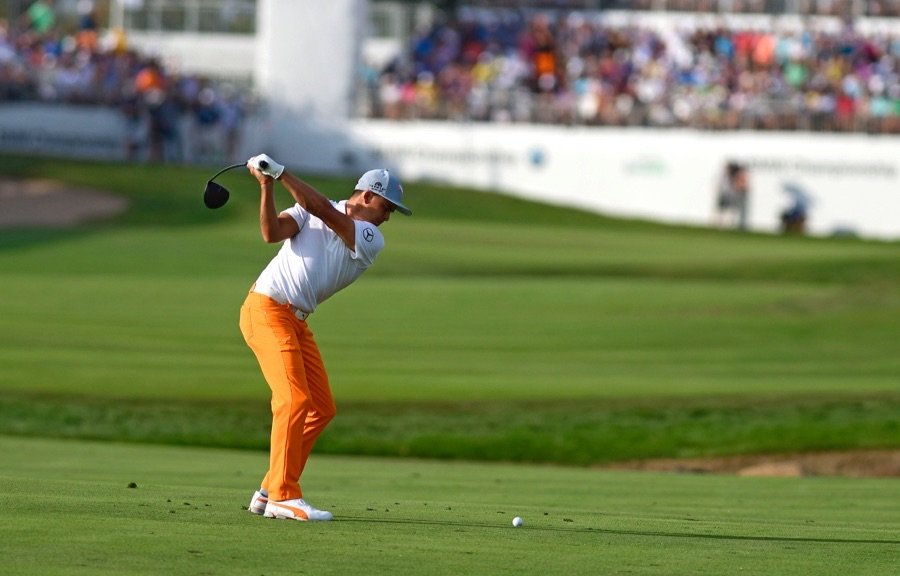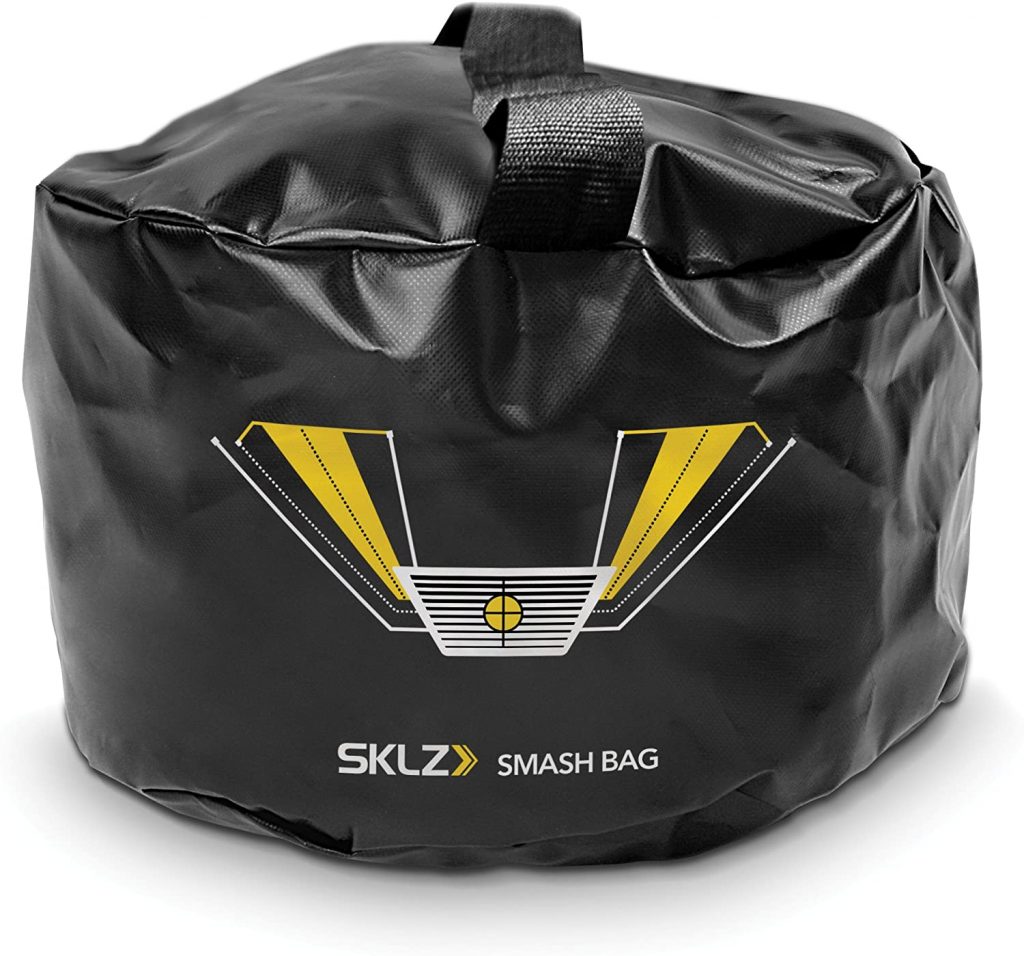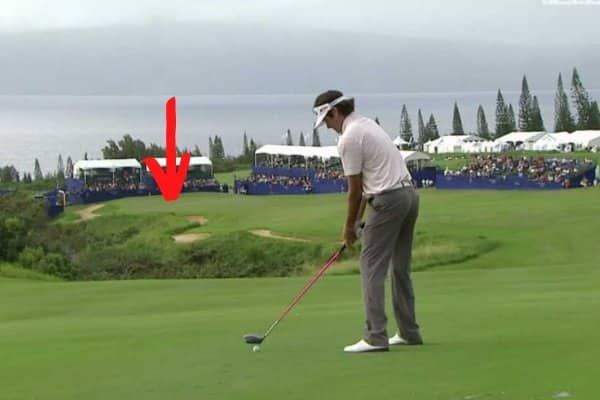When it comes to the hardest shots in golf, hitting driver off the deck is right up there on the difficulty scale.
The ‘big dog’ is already tough enough to hit long and straight off a tee – leading a lot of players to add driving irons to their bag as a back-up fairway finder – but attempting to flush it from the middle of the fairway is a challenge on a whole new level.
Many amateurs when attempting to hit driver off the deck get anxious and swing too hard in an attempt to bludgeon it as far as possible.
Others make the mistake of trying to ‘scoop’ the ball into the air with their hands, rather than compressing it, which often has the opposite effect and leads to either fat or thin shots.
But, the secret to hitting driver off the deck is actually rather simple and doesn’t need to be overcomplicated.
The key steps to hitting driver off the deck are: place the ball back in your stance; open your stance slightly to your target; keep your chest centred over the ball like you would an iron; maintain your balance and control by swinging easy; strike downwards and take a small divot.
This may seem a lot to remember, but essentially you want to hit your driver similar to you would a long iron, with the main difference being ball position.
In this article, I’ll elaborate further on these steps and answer all the need-to-know questions about hitting driver off the deck so that you can be reaching those long Par 5s in two shots.
Table of contents
What does driver off the deck mean in golf?
Hitting driver off the deck simply means to strike the ball when it is at rest on the ground – typically either from the fairway or rough – while using driver. It is a shot often used by players when attempting to reach the green on long Par 5 holes in two shots.
The reason ‘driver off the deck’ is such an iconic shot in golf is because of the level of skill required to pull it off.
The driver is the lowest lofted club in your bag (aside from your putter) meaning it can be tricky to get the ball airborne without first propping it up on a tee, and also has the slimmest margin for error.
A slightly open clubface or swing path that is too far over-the-top can lead to huge slices, which are the most common misses when attempting to hit driver off the deck and can lead to big trouble and large scores.
But, on the flipside, the pay-off from contacting the ball sweetly is one of the best feelings in golf and will likely leave you a short chip onto the green, or even an eagle putt if you flush it perfectly.
The late great Arnold Palmer demonstrated this perfectly during The American Express PGA tournament in 2001, when at 71-years-old he striped a driver off the deck and left himself a long eagle putt, much to the delight of the crowd.
When should you hit driver off the deck?
Average players should only attempt to hit driver off the deck when they have a good lie; the fairway is wide; and the entrance to the green is absent of water hazards or out of bounds areas. Driver off the deck is a high-risk shot and sticking to this checklist will help lessen the likelihood of finding trouble.
In reality, driver off the deck is the ultimate ‘risk versus reward’ shot.
The upside is if you pull it off, you’ll give yourself a great chance at eagle, birdie or par; however, the downside is that should things go awry, you open yourself up to bogeys, double bogeys or worse.
Professional players are highly skilled and are far more likely to pull off a successful driver off the deck than the average weekend warrior, however – despite this – you’ll very rarely see them attempt this shot, especially if they are in winning contention.
The big exception to this, of course, came from Scotsman Colin Montgomerie in 1996 when, despite leading the Dubai Desert Classic by one shot coming into the 72nd hole, decided to hit driver over the water on 18, landing it 20-feet from the hole, to seal victory over Miguel Ángel Jiménez.
But most of the time, they will only hit driver off the deck when they need to reach the green in two shots, have a great lie in the middle of the fairway, and have a wide landing area at the front of the putting surface that is devoid of any water or out of bounds fences.
American superstar Phil Mickelson is another rare exception to this rule, however, and has been known to blaze big dog out of the thick rough on more than one occasion (a reason why they call him ‘Phil the Thrill’).
Should amateur golfers hit driver off the deck?
As hitting driver off the deck is one of the hardest shots in golf, amateurs should usually only attempt it when they are approaching an open, unprotected green from a wide, expansive fairway. Amateurs should avoid hitting driver off the deck when hazards are nearby.
At the end of the day, golf is all about shooting the lowest score possible and as an amateur you need to weigh up the pros and cons of hitting driver off the deck.
Is it more likely that you will A) flush the perfect shot from 250+ yards and give yourself a short chip or eagle putt? Or B) hit a huge, carving slice or hook that is likely to end up behind a tree or in the deep, thick rough?
If the answer is B the majority of the time, then you may be better off laying up on long Par 5s and instead trying to hit a wedge close for your third shot and spin it back towards the hole.
If you’re in the market for a new wedge, we’ve listed the best available choices here.
Why do pro golfers hit driver off the deck?
Pro golfers hit driver off the deck when they cannot reach a Par 5 green with a fairway wood for their second shot. Most of the time pros will use a 3-wood or even long iron to reach Par 5 greens in two, however longer holes may require them to hit driver in order to achieve the necessary distance.
Unlike us mere mortals, professional golfers – such as those who play on the PGA or European Tours – hit the ball extremely far and more often than not will have no trouble reaching the putting surface with their second shot.
But golf course designers are starting to make holes longer and longer to try and negate the distance pros can generate, and as a result some Par 5s are so long that not even the best in the world can reach the green with a fairway wood or hybrid and need to hit driver off the deck in order to get there.
Of course, this is rare and it’s not very often you see pros attempt to hit driver off the deck as it is – as I’ve explained above – a shot that comes with added risk.

How to hit driver off the deck in 5 steps
While it can seem a daunting shot to play, hitting driver off the deck requires you to execute just five simple steps (three of which can be completed before you even start your takeaway).
Oh, and don’t forget: to hit driver off the deck, you need to own a driver. You can check out our top picks for beginners here.
But follow the steps below, and practice them regularly either on the course or range, and you should start flushing driver off the deck in no time.
Step 1: Move the ball back in your stance
The first step is a simple one: move the ball back towards the middle of your stance (either centre, or slightly forward of centre).
For maximum distance off the tee, driver is typically played off the inside of your lead foot at address.
But because you’re hitting the ball off the deck, you will need a more descending angle of attack and moving the ball back in your stance will help you deliver the club on a slightly steeper trajectory and allow the natural loft of the driver to elevate the ball into the air.
Step 2: Open your stance slightly
Because you’ve moved the ball back in your stance, you’re going to strike it earlier in your downswing arc than you would if it was placed inside your lead foot – and as a result you’ll be more prone to hitting shots out to the right (for a right-handed player).
To counteract this, you should open your stance slightly by pointing your feet, chest and shoulders slightly to the left of your target line.
Step 3: Keep your chest over the ball
Keeping your chest over the ball is arguably the most important step when hitting driver off the deck.
When playing off a tee with driver, the correct technique is to tilt your chest and shoulders slightly away from the ball as this will help create the ideal launch conditions to maximise distance and quality of strike (with the least amount of spin).
However, when hitting driver off the deck, you need to set-up more as if you are hitting a mid or long iron by keeping your chest and shoulders more level over the ball (which is also known as ‘covering the ball’).
Doing this will help you compress the ball better at impact an increase the chances of getting it airborne with solid contact.
A great way to practice this movement is with an impact bag (however, I’d recommend using an iron, and translate those feelings to driver on the course). You can read our top picks here.

Step 4: Stay balanced and swing easy
If you watch amateurs attempt to hit driver off the deck, you can guarantee the majority of them do this step incorrectly.
Rather than staying balanced and swinging smoothly, most weekend warriors will swing out of their shoes and either hit it extremely fat, thin or miss the ball altogether.
It’s crucially important not to overswing when hitting driver off the deck – I cannot stress this enough.
You should be in full control and be able to hold a balanced finish position after striking the ball (rather than stumbling around having tried to strike it with 150 percent effort).
When you watch the pros play this shot, it always looks easy and rhythmic; they never lose their balance; and they always hold their finish position.
A great way to improve your balance is to practice barefoot at the range, as not having that extra grip your golf shoes would normally afford will force you to smoothen your swing out.
Step 5: Strike downwards and take a small divot
The final step is another one that commonly catches amateur players out.
Mid-to-high handicappers regularly make the mistake of thinking ‘in order to get the ball airborne when hitting driver off the deck, I need to hit up on it’.
This is actually the opposite of what they should be doing and will likely lead to poor strikes, brought about as they flip their hands at impact to try and ‘scoop’ the ball into the air.
When playing driver from the fairway, you should aim to brush the ground with the club and take a small divot – I’m not talking about a huge crater, as this is also counterproductive and will lead to poor results.
You should strike the ball with just enough of a descending blow that you cut the first few layers of grass and leave a noticeable divot, but without significantly disrupting the dirt below the turf.
A nice, shallow divot is what you’re aiming for.
Final message
Hitting driver off the deck is one of the best feelings in golf – but it’s also a shot fraught with danger if it isn’t executed well.
To reduce the chances of it ruining your round, you should only consider hitting driver off the deck when conditions are favourable and where the potential benefits significantly outweigh the negatives.
Follow our five set-up steps, especially swinging easy and with balance, and driver off the deck could become a great weapon you can use to starting hitting those super-long Par 5s more regularly.
- TaylorMade SIM2 Max Driver vs M4 Driver: Worth it in 2024? - April 15, 2024
- 3 Ways to Win the Mental Game with the Bridgestone Mindset Golf Ball - March 29, 2024
- TaylorMade SIM Max & SIM2 Max Drivers: Are they Still Relevant in 2024? - March 9, 2024


